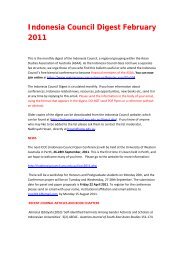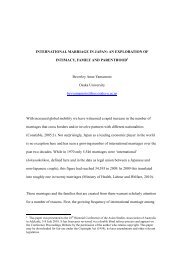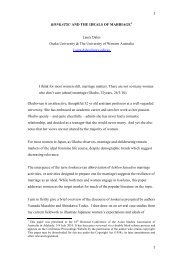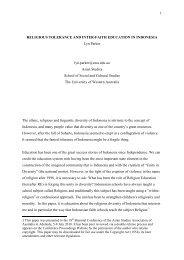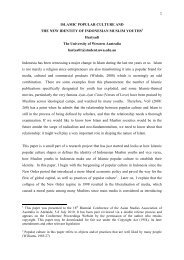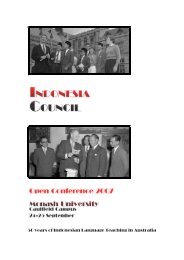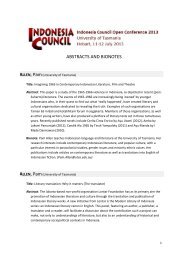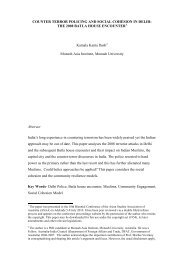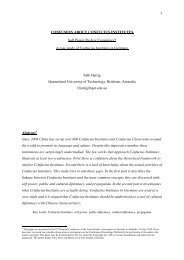the confiscation and shipment of Japanese war record paintings
the confiscation and shipment of Japanese war record paintings
the confiscation and shipment of Japanese war record paintings
You also want an ePaper? Increase the reach of your titles
YUMPU automatically turns print PDFs into web optimized ePapers that Google loves.
6<br />
acquired through o<strong>the</strong>r means not necessarily related or sanctioned by Allied forces.<br />
The <strong>of</strong>ficial number <strong>of</strong> <strong>Japanese</strong> <strong>war</strong> <strong>record</strong> <strong>paintings</strong> in <strong>the</strong> custody <strong>of</strong> <strong>the</strong> NMMA st<strong>and</strong>s at<br />
only 153 works. However, <strong>the</strong> documents presented above clearly show o<strong>the</strong>rwise. Part <strong>of</strong> <strong>the</strong><br />
discrepancy can be attributed to how <strong>the</strong> <strong>paintings</strong> were counted. Some <strong>of</strong> <strong>the</strong> confiscated <strong>paintings</strong> are<br />
works executed in multiple panels. For example, in <strong>the</strong> Occupation-era lists, Hashimoto Kansetsu's<br />
triptych entitled “Scenes Along <strong>the</strong> Hwangpu River on 8 December 1941” was counted as 3 separate<br />
works. In <strong>the</strong> NMMA catalogue, however, all three parts were counted as one work. If one is to use<br />
<strong>the</strong> same counting convention employed by <strong>the</strong> NMMA, <strong>the</strong> total number <strong>of</strong> <strong>paintings</strong> shipped to <strong>the</strong><br />
US would only amount to 152 works.<br />
In a 10 August 1946 memo issued by <strong>the</strong> Office <strong>of</strong> <strong>the</strong> Chief Engineer to <strong>the</strong> Chief <strong>of</strong> Staff <strong>of</strong><br />
<strong>the</strong> Occupation Forces, it was stated that 152 confiscated <strong>paintings</strong> were under <strong>the</strong> custody <strong>of</strong> <strong>the</strong><br />
Engineers <strong>and</strong> plans were being prepared for <strong>the</strong>se to be exhibited to Allied personnel. 15 This sum<br />
corresponds to <strong>the</strong> number <strong>of</strong> items in <strong>the</strong> previously mentioned MacArthur list, fur<strong>the</strong>r giving<br />
credence to <strong>the</strong> <strong>the</strong>ory that it is <strong>the</strong> earliest listing <strong>of</strong> confiscated <strong>Japanese</strong> <strong>war</strong> <strong>record</strong> <strong>paintings</strong>.<br />
However, if one is to reconcile <strong>the</strong> counting system <strong>of</strong> <strong>the</strong> 1946 list with <strong>the</strong> NMMA list, in 1946, <strong>the</strong>re<br />
were only 150 confiscated <strong>paintings</strong> in Allied custody.<br />
Later on, <strong>the</strong> number 153 confiscated <strong>Japanese</strong> <strong>war</strong> <strong>record</strong> <strong>paintings</strong> would <strong>of</strong>ten be repeated in<br />
various Occupation documents to refer to <strong>the</strong> amount <strong>of</strong> <strong>paintings</strong> confiscated. For example, in a 27<br />
April 1951 conference to discuss <strong>the</strong> final disposition <strong>of</strong> <strong>the</strong> confiscated <strong>paintings</strong> between <strong>the</strong> Office<br />
<strong>of</strong> <strong>the</strong> Chief Engineer, <strong>the</strong> Religion <strong>and</strong> Cultural Resources Section <strong>of</strong> <strong>the</strong> Civil Information <strong>and</strong><br />
Education Division <strong>and</strong> <strong>the</strong> Headquarters <strong>and</strong> Services Comm<strong>and</strong>, 153 was given as <strong>the</strong> definitive<br />
number <strong>of</strong> confiscated <strong>paintings</strong>. 16 The same number <strong>of</strong> confiscated works would be repeated in o<strong>the</strong>r<br />
documents relating to <strong>the</strong> <strong>confiscation</strong> <strong>and</strong> <strong>shipment</strong> <strong>of</strong> <strong>the</strong> confiscated <strong>Japanese</strong> <strong>war</strong> <strong>record</strong> <strong>paintings</strong>,<br />
from May to July 1951.<br />
It is easy to assume that since 153 <strong>paintings</strong> are now with <strong>the</strong> National Museum <strong>of</strong> Modern Art,<br />
all <strong>of</strong> <strong>the</strong> confiscated <strong>paintings</strong> were returned to Japan. This is, <strong>of</strong> course, a false assumption.<br />
A close comparison <strong>of</strong> <strong>the</strong> lists reveals that <strong>the</strong>re are 3 <strong>paintings</strong> listed as confiscated <strong>and</strong><br />
shipped to <strong>the</strong> US in <strong>the</strong> Occupation-era lists are not in <strong>the</strong> present NMMA collection. These <strong>paintings</strong><br />
are Okuse Eizō's “Air Fighting,” Katsuda Tetsu's “Divine Soldiers Descend on Menado” <strong>and</strong> Ueno<br />
15 “<strong>Japanese</strong> War Art Paintings,” 10 August 1946, micr<strong>of</strong>iche, CIE (C) 06719, Modern <strong>Japanese</strong> Political History Materials<br />
Room, National Diet Library.<br />
16 “Conference Report,” 27 April 1951, micr<strong>of</strong>iche, CIE (A) 08580, ibid.



